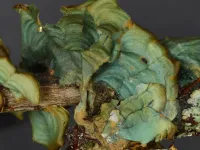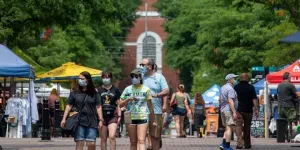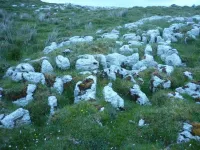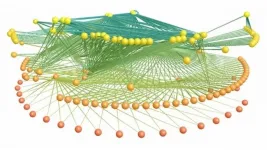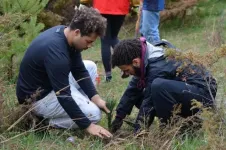(Press-News.org) GAINESVILLE, Fla. --- Scientists have found a new species of fleshy verdigris lichen, thanks to DNA analysis of museum specimens. Misidentified by its original collectors, the lichen is only known from 32 specimens collected in North and Central Florida scrubland between 1885 and 1985. Now the hunt is on to find it in the wild - if it still exists.
The lichen, named Cora timucua in honor of Florida's Timucua people, is critically endangered, even more so than the federally protected Florida perforate reindeer lichen, and possibly extinct. Researchers are holding out hope that C. timucua may persist in undisturbed pockets of the state's dwindling pine scrub habitat, though recent searches came up empty.
"The million-dollar question is 'Where is this lichen?'" said Laurel Kaminsky, a digitization manager at the Florida Museum of Natural History and co-author of the study. "The optimist in me says it's still out there."
Kaminsky said the sparse information recorded by the lichen's collectors makes it difficult to retrace their steps. More widespread in the early 20th century, C. timucua was collected only from the Ocala National Forest and O'Leno State Park after 1968, two of Florida's last remaining scrub ecosystems. Citrus groves and urban developments have replaced up to 90% of the state's sand pine scrub.
"If it's anywhere, it's going to take a lot of looking in very specific habitats to find it," Kaminsky said.
Affectionately dubbed "Timucua heart lichen," the new species resembles a shelf fungus and is about the size of a sand dollar with scalloped edges. It can be distinguished from wood-rotting fungi by its texture: felty and papery, with curved lobes and a cracked underside.
But its color is an enigma. The lichen is light gray when dry, but specimens turn a deep blue-green and bleed a reddish-brown pigment when wet in a laboratory setting. Without photos and detailed descriptions of the lichen in nature, scientists don't yet know how it reacts to moisture in the wild.
"In general, people take nature for granted, and the Timucua heart lichen story might tell us sometimes we are too late," said Manuela Dal Forno, senior author of the study and a lichenologist at the Botanical Research Institute of Texas. "Right now, we need everybody's help in trying to locate this lichen in Florida."
Kaminsky said Timucua heart lichen likely prefers old-growth pine scrub habitat, which has taller trees and established populations of native Florida plants, such as rusty lyonia, a shrub characterized by reddish fibers lining its leaves. But hikers should avoid collecting any potential specimens they find: Instead, they can photograph the lichen and upload images to the END
Rare lichen unique to Florida discovered in museum collections, may be extinct
2021-01-14
ELSE PRESS RELEASES FROM THIS DATE:
New study: Without right messaging, masks could lead to more COVID-19 spread
2021-01-14
A novel new study suggests that the behavior public officials are now mandating or recommending unequivocally to slow the spread of surging COVID-19--wearing a face covering--should come with a caveat. If not accompanied by proper public education, the practice could lead to more infections.
The finding is part of an unique study, just published in JMIR Public Health and Surveillance, that was conducted by a team of health economists and public health faculty at the University of Vermont's Larner College of Medicine in partnership with public health officials for the state of Vermont.
The study combines survey data gathered from adults living in northwestern Vermont with test results that showed whether a subset of them had contracted COVID-19, a dual research ...
Researchers show Irish soil can offer more hope in fight against antibiotic resistance
2021-01-14
Scientists who highlighted the bug-busting properties of bacteria in Northern Irish soil have made another exciting discovery in the quest to discover new antibiotics.
The Traditional Medicine Group, an international collaboration of scientists from Swansea University, Brazil and Northern Ireland, have discovered more antibiotic-producing species and believe they may even have identified new varieties of antibiotics with potentially life-saving consequences.
Antibiotic resistant superbugs could kill up to 1.3 million people in Europe by 2050 - the World Health Organisation (WHO) describes the problem as "one of the biggest threats to global health, food security, and development today".
The search for replacement antibiotics to combat ...
Accounting for the gaps in ancient food webs
2021-01-14
If you want to understand an ecosystem, look at what the species within it eat. In studying food webs -- how animals and plants in a community are connected through their dietary preferences -- ecologists can piece together how energy flows through an ecosystem and how stable it is to climate change and other disturbances. Studying ancient food webs can help scientists reconstruct communities of species, many long extinct, and even use those insights to figure out how modern-day communities might change in the future. There's just one problem: only some species left enough of a trace for scientists to find eons later, leaving large gaps in the fossil record -- and researchers' ability to piece together the food webs from the past.
"When things die and get preserved as fossils, all the ...
Galaxies hit single, doubles, and triple (growing black holes)
2021-01-14
When three galaxies collide, what happens to the huge black holes at the centers of each? A new study using NASA's Chandra X-ray Observatory and several other telescopes reveals new information about how many black holes are furiously growing after these galactic smash ups.
Astronomers want to learn more about galactic collisions because the subsequent mergers are a key way that galaxies and the giant black holes in their cores grow over cosmic time.
"There have been many studies of what happens to supermassive black holes when two galaxies merge," said Adi Foord of Stanford University, who led the study. "Ours is one of the first to systematically look at what happens to ...
Physical virology shows the dynamics of virus reproduction
2021-01-14
The reproductive cycle of viruses requires self-assembly, maturation of virus particles and, after infection, the release of genetic material into a host cell. New physics-based technologies allow scientists to study the dynamics of this cycle and may eventually lead to new treatments. In his role as physical virologist, Wouter Roos, a physicist at the University of Groningen, together with two longtime colleagues, has written a review article on these new technologies, which was published in Nature Reviews Physics on 12 January.
'Physics has been used for a long time to study viruses,' says Roos. 'The laws of ...
Physical frailty syndrome: a cacophony of multisystem dysfunction
2021-01-14
In the inaugural issue of the journal Nature Aging a research team led by aging expert Linda P. Fried, MD, MPH, dean of Columbia University Mailman School of Public Health, synthesizes converging evidence that the aging-related pathophysiology underpinning the clinical presentation of phenotypic frailty (termed as "physical frailty" here) is a state of lower functioning due to severe dysregulation of the complex dynamics in our bodies that maintains health and resilience. When severity passes a threshold, the clinical syndrome and its phenotype are diagnosable. This paper summarizes the evidence meeting criteria for physical frailty as a product of complex system dysregulation. ...
Mapping our sun's backyard
2021-01-14
Astronomers have curated the most complete list of nearby brown dwarfs to date thanks to discoveries made by thousands of volunteers participating in the Backyard Worlds citizen science project. The list and 3D map of 525 brown dwarfs -- including 38 reported for the first time -- incorporate observations from a host of astronomical instruments including several NOIRLab facilities. The results confirm that the Sun's neighborhood appears surprisingly diverse relative to other parts of the Milky Way Galaxy.
Mapping out our own small pocket of the Universe is a time-honored quest within astronomy, and ...
New classification marks paradigm shift in how conservationists tackle climate change
2021-01-14
NEW YORK (January 14) -- A new study co-authored by researchers from the Wildlife Conservation Society's (WCS) Global Conservation Program and the University of British Columbia (UBC) Faculty of Forestry introduces a classification called Resistance-Resilience-Transformation (RRT) that enables the assessment of whether and to what extent a management shift toward transformative action is occurring in conservation. The team applied this classification to 104 climate adaptation projects funded by the WCS Climate Adaptation Fund over the past decade and found differential responses toward transformation ...
Behaviors surrounding oral sex may increase HPV-Related cancer risk
2021-01-14
A wide breadth of behaviors surrounding oral sex may affect the risk of oral HPV infection and of a virus-associated head and neck cancer that can be spread through this route, a new study led by researchers at the Johns Hopkins Kimmel Cancer Center suggests. These findings add nuance to the connection between oral sex and oropharyngeal cancer -- tumors that occur in the mouth and throat -- and could help inform research and public health efforts aimed at preventing this disease.
The findings were reported Jan. 11 in the journal Cancer.
In the early 1980s, researchers realized that nearly all cervical cancer is caused by the human papillomavirus (HPV), a DNA virus from the Papillomaviridae family. Although about 90% of HPV infections ...
The richer you are, the more likely you'll social distance, study finds
2021-01-14
The higher a person's income, the more likely they were to protect themselves at the early stages of the Covid-19 pandemic in the United States, Johns Hopkins University economists find.
When it comes to adopting behaviors including social distancing and mask wearing, the team detected a striking link to their financial well-being. People who made around $230,000 a year were as much as 54% more likely to increase these types of self-protective behaviors compared to people making about $13,000.
"We need to understand these differences because we can wring our hands, and we can blame and shame, but in a way it doesn't matter," said Nick Papageorge, the Broadus Mitchell Associate Professor of Economics. "Policymakers just need to recognize who is going ...
